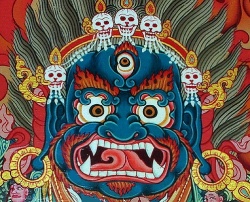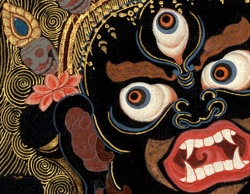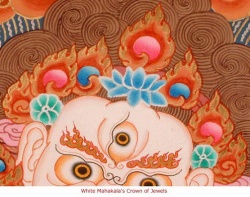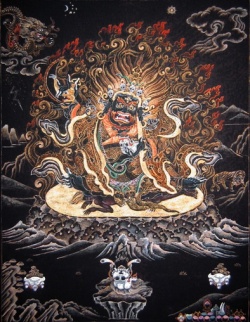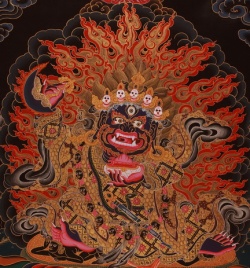Wrathful Forms
People who are not accustomed to the 'language' of Tibetan Buddhist images are often surprised to see the wrathful deities for the first time. Perhaps, if you visited the link in the previous sentence, you are even pleasantly surprised.
One category is that of the herukas, a class of Vajrayana deities such as Chakrasamvara that is semi-wrathful with intimidating even terrible features. They are represented as partially nude with an upper garment of human skin and a tiger skin around their hips. They have a 5-skull headdress and carry bone rosaries, a staff or trident and a damaru (pellet drum) like the Hindu god, Shiva. Herukas are described in Tibetan books as beautiful, heroic, awe-inspiring, stern and majestic.
The eight Dharmapalas, Protectors of the teaching of the buddhas, have this appearance but in fact they are bodhisattvas - embodiments of compassion that can manifest out of Emptiness to act in an extremely wrathful way for the sake of sentient beings. [link is to Nitin's newsletter of Feb. 2001.]
Called in Tibetan, Drag-ched, the dharmapalas or defenders of Buddhism, are the 8 bodhisattvas: Mahakala, Yamantaka, Kubera, Hayagriva, Palden Lhamo, Changpa, Yama, and Begtse.
Tantric texts describe the very wrathful deities as terrifying. Stout with short but very strong limbs, many have several heads, hands and feet. Their complexions are likened to storm clouds, metals or precious stones, eg. black as the "cloud which appears at the end of a kalpa,” or “like a mountain of crystal” or like pure gold; of a red as "when the sun rises and its rays strike a huge mountain of coral.”
Their skin is oiled with sesame in the fashion of ancient times, or dusted like that of a sadhu with ashes from a funeral pyre; more horribly, it is covered with spots of blood and shiny specks of human fat.
They grimace fiercely with a maw from which protrude fangs of copper or iron. Often, in a profile view the upper teeth gnash the lower lip. A miasma of disease may issue from their mouths; a storm from flattened nostrils. They glower with three bulging, bloodshot eyes.
Mahakala Great Dark One is the name given to a number of the wrathful forms, mainly of Chenrezig. But not all wrathful forms of Chenrezig are Mahakala.
The details of Mahakala's form depend on the different lineages and situation contexts. There are several six-armed ones characteristic of the dharma protector, and there are also four-armed and two-armed ones. See a white or Sita Mahakala (Gonpo Karpo).
For example, as protectors of the different teaching lineages there are the two-armed, big-mouthed Mahakala Bernachen of the Karma Kagyu, four-armed Mahakala shown here who is protector of the Drikung Kagyu, and six-armed Mahakala of the Gelugpas.
Changpa Karpo (White Brahma) is the Buddhist view of Brahma. In this context, the usually 4-faced, 4-armed deity that in Indian mythology traverses space seated with Lakshmi his consort, on Garuda is here mounted on a white horse, brandishing a sword. He is a "defender of the faith" and does not usually have the fierce-some attributes of the others. His head-dress is topped by a conch shell jewel and over his robes he wears Mongolian armor.
Hindu mythology tells how Brahma had designs on his own daughter, though she managed always to place herself above his many heads so he could not get at her. The Tibetan account has a similar motif:
Changpa Karpo rode a wondrous horse that sailed the sky during the day, but at night descended to earth. Once, while in the heavens, he seduced a goddess named Dhersang, and stole a wish-fulfilling jewel. The guardians of heaven grabbed him by his tongue, flung him to the ground, and took back the jewel along with his very heart.
This naturally resulted in an increase in his viciousness -- he murdered men and raped women. He met his match in Ekajati, who when he tried to touch her, whipped him so hard on his thigh with her turquoise-bedecked silk undergarment that he became crippled.
This wound, similar to that received by Jacob in the Old Testament as he wrestled with an angel, transformed him into a protector or dharmapala.
Beg-tse (The Master of War) emerged as a dharmapala after the Mongols under Altan Khan took Refuge in 1577 via the teachings of the Third Dalai Lama.
Like Changpo Karpo, he is also depicted mounted and in armour. With his right hand he brandishes his scorpion-hilt sword, his left hand clutching his bow is raised to his mouth as he is about to eat the heart of an enemy.
Vajrabhairava seems to have derived from the fierce Indian god Shiva in his form of Bhairava (Terrifier); to Buddhists this dark bull-headed figure has become Yamantaka, Dorje Jigche Jigji] the Death-Slayer who is a fierce form of the gentle Mañjusri, one of the Buddha's disciples. Fearsome in appearance they may be, but all of these deities are manifestations of compassion.
Some Nepalese Buddhist deities are particular to that culture. Mahasamber, 'The Great Defender' is a Nepali example of Yamantaka, the complex Buddhist guardian:
He has seventeen heads in five rows, four in each row and one at the top. The main head of the four in each row faces the front and is blue on the right and green on the left. The heads on the blue side are yellow and the pairs of heads on the green side are blue, green and red. The heads are larger at the bottom and smaller at the top. All the faces are demonic, ie square shaped with three bulging eyes, heavy eyebrows, gaping mouths and fangs. The colour division of the main faces is continued all the way down the body, the right half being blue, the left half green. he has two sets of 17 and 18 arms, ie making 70 arms. Each of Maha Sambara’s feet has six toes and he stands with legs astride in alidhasana.
There are also four main arms, besides the four in which he embraces his consort, Vajravarahi.
